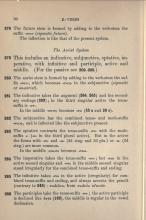279. This includes an indicative, subjunctive, optative, imperative, with infinitive and participle, active and middle. (For the passive see §§ 302 – 309.)
280. The aorist stem is formed by adding to the verb-stem the suffix -σα:ε-, which becomes -σω:η- in the subjunctive (sigmatic or σα- aorist).
281. The indicative takes the augment (§ 264 and 265) and the secondary endings (§ 263); in the third singular active the tense suffix is -σε-. In the middle -σα-σο becomes -σω (§§ 55.a and 29.c).
282. The subjunctive has the combined tense and mode suffix -σω:η-, and is inflected like the subjunctive present.
283. The optative contracts the tense suffix -σα- with the mode suffix -ι- (-ιε- in the third plural active). But in the active the forms with -σε- and -ια- (2nd singular and 3rd plural) or -ιε- (3rd singular) are more common. In the middle -σαι-σο becomes -σαιο.
284. The imperative takes the tense suffix -σα-; but -σον in the active second singular and -σαι in the middle second singular stand irregularly for the combined tense suffix and ending.
285. The infinitive takes -σαι in the active (irregularly) for combined tense suffix and ending, and always accents the penult (contrary to § 249).
παιδεῦσαι from παιδεύω educate
286. The participles take the tense suffix -σα-; the active participle is declined like ἅπᾱς (§ 162), the middle is regular in the vowel declension.

